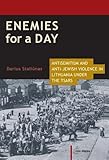Enemies for a Day : Antisemitism and Anti-Jewish Violence in Lithuania under the Tsars / Darius Staliūnas.
Material type: TextSeries: Historical Studies in Eastern Europe and EurasiaPublisher: Budapest ; New York : Central European University Press, [2022]Copyright date: ©2015Description: 1 online resource (296 p.)Content type:
TextSeries: Historical Studies in Eastern Europe and EurasiaPublisher: Budapest ; New York : Central European University Press, [2022]Copyright date: ©2015Description: 1 online resource (296 p.)Content type: - 9789633860946
- 305.892/40479309034 23
- DS146.L53 .S735 2015
- online - DeGruyter
| Item type | Current library | Call number | URL | Status | Notes | Barcode | |
|---|---|---|---|---|---|---|---|
 eBook
eBook
|
Biblioteca "Angelicum" Pont. Univ. S.Tommaso d'Aquino Nuvola online | online - DeGruyter (Browse shelf(Opens below)) | Online access | Not for loan (Accesso limitato) | Accesso per gli utenti autorizzati / Access for authorized users | (dgr)9789633860946 |
Frontmatter -- Table of Contents -- Preface and Acknowledgments -- List of abbreviations -- Introduction -- 1 The Blood Libel in Nineteenth-Century Lithuania -- 2 Antisemitism in Lithuania -- 3 Lithuania during the “Storms in the South” (Early 1880s) -- 4 How Insulted Religious Feelings Turned into Pogroms: Lithuania in 1900 -- 5 Antisemitic Tensions and Pogroms in the Late Imperial Period -- 6 Comparative Perspective -- Conclusion -- Bibliography -- Index
restricted access online access with authorization star
http://purl.org/coar/access_right/c_16ec
This book explores anti-Jewish violence in Russian-ruled Lithuania. It begins by illustrating how widespread anti-Jewish feelings were among the Christian population in 19 th century, focusing on blood libel accusations as well as describing the role of modern antisemitism. Secondly, it tries to identify the structural preconditions as well as specific triggers that turned anti-Jewish feelings into collective violence and analyzes the nature of this violence. Lastly, pogroms in Lithuania are compared to anti-Jewish violence in other regions of the Russian Empire and East Galicia. This research is inspired by the cultural turn in social sciences, an approach that assumes that violence is filled with meaning, which is “culturally constructed, discursively mediated, symbolically saturated, and ritually regulated.” The author argues that pogroms in Lithuania instead followed a communal pattern of ethnic violence and was very different from deadly pogroms in other parts of the Russian Empire.
Mode of access: Internet via World Wide Web.
In English.
Description based on online resource; title from PDF title page (publisher's Web site, viewed 30. Aug 2022)


